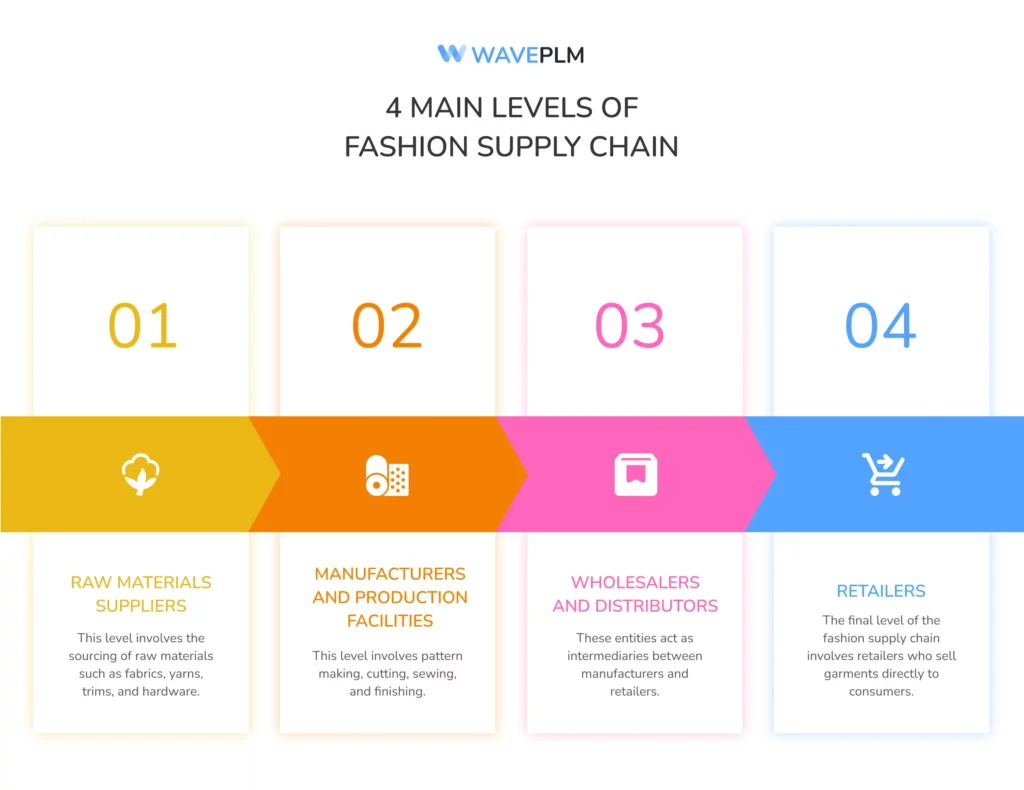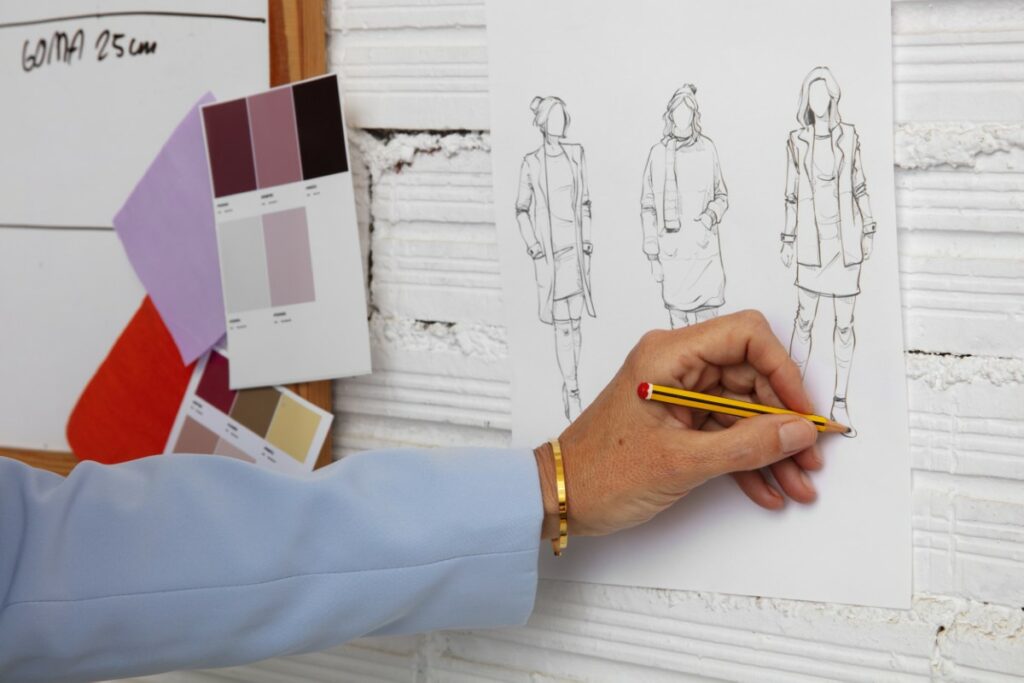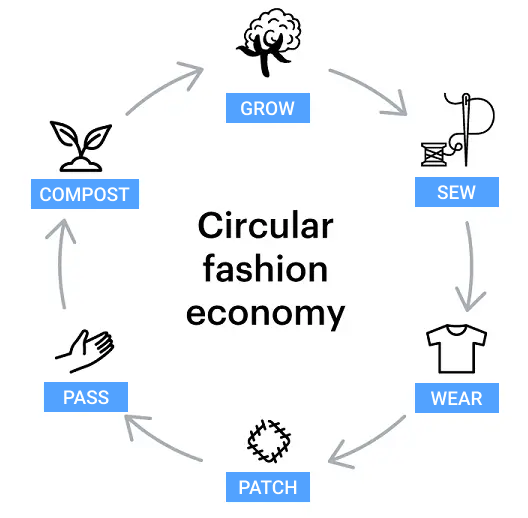
In the world of fashion, the journey from concept to catwalk involves a complex network of threads intertwining across continents. Behind the glamor and glitz lie the intricate workings of the fashion industry’s global supply chain, a process that is as fascinating as it is fundamental. Let’s unravel the layers and explore how this intricate web functions.
The clothing, textiles, and footwear sector relies heavily on labor. It’s estimated that this industry employs tens of millions of garment workers globally, with the majority being women.
But what constitutes a clothing supply chain? Essentially, the fashion supply chain encompasses the journey of clothing production, from the acquisition of raw materials to the manufacturing of garments in factories, and finally, the distribution network that brings the finished products to consumers. This process is intricate, rarely involving all stages from material sourcing to sales in one single location.
4 Main Levels of Fashion Supply Chain
In the fashion industry, the supply chain management typically consists of four main levels:
- Raw Materials Suppliers: This level involves the sourcing of raw materials such as fabrics, yarns, trims, and hardware. Raw materials suppliers provide the foundational components necessary for garment production. They can include textile mills, dye houses, hardware manufacturers, and other entities that produce the basic materials needed for clothing manufacturing.
- Manufacturers and Production Facilities: Once raw materials are sourced, they are sent to manufacturers and production facilities where garments are produced. This level involves various processes such as pattern making, cutting, sewing, and finishing. Manufacturers can range from small-scale workshops to large factories, often located in countries with lower labor costs.
- Wholesalers and Distributors: After garments are produced, they are typically sold in bulk to wholesalers or distributors. These entities act as intermediaries between manufacturers and retailers, purchasing large quantities of goods and selling them to retailers at a markup. Wholesalers and distributors may operate regionally, nationally, or internationally, depending on the scale of their operations.
- Retailers: The final level of the fashion supply chain involves retailers who sell garments directly to consumers. Retailers can include brick-and-mortar stores, online retailers, department stores, boutiques, and speciality shops. They play a crucial role in merchandising, marketing, and selling fashion products to consumers, and they often have a direct interface with the end-users of the garments.

These four levels of the fashion industry supply chain work together to bring clothing products from the initial sourcing of raw materials to the final sale to consumers. Each level performs specific functions and adds value to the process, contributing to the overall efficiency and effectiveness of the fashion supply chain management.
Introduction to the Fashion Supply Chain
The fashion supply chain encompasses the entire lifecycle of a garment, from concept to consumer. It begins with the creative vision of designers who conceive of new styles and trends and ends with the delivery of finished garments to retail outlets or directly to consumers. At each stage of the process, the supply chain managers a multitude of actors and activities come into play, each with its own set of challenges and opportunities.
1. Design and Development
At the outset of the supply chain is the design and development phase, where designers draw inspiration from a myriad of sources to create new styles and collections. This phase involves extensive research, trend forecasting, and creative experimentation to translate abstract concepts into tangible garments. Designers collaborate closely with merchandisers, buyers, and product developers to refine their ideas and ensure they align with market and consumer demand, and brand identity.

2. Material Sourcing and Procurement
Once the designs are finalized, the next step in the whole supply chain process is material sourcing and procurement. This involves identifying and acquiring the raw materials needed to produce the garments, including fabrics, trims, and hardware. Material sourcing is a critical aspect of the supply chain, as the quality, cost, and availability of materials can significantly impact the final product.
3. Manufacturing and Production
With materials in hand, the production phase begins, where garments are manufactured in factories around the world. This stage involves a myriad of processes, including pattern-making raw material itself, cutting, sewing, and finishing, all of which require skilled labor and specialized equipment. Manufacturing is often outsourced to countries with lower labor costs, such as China, Bangladesh, and Vietnam, where large-scale production facilities can accommodate the volume and complexity of modern fashion production.

4. Quality Control and Assurance
Quality control is a crucial aspect of the production process, ensuring that garments meet the brand’s standards for fit, finish, and durability. This involves rigorous testing and inspection at various stages of production, from sourcing raw materials through to finished goods. Quality control measures help identify and address defects and inconsistencies before they reach the consumer, thereby minimizing returns and reputation damage.
5. Logistics and Distribution
Once production is complete, the garments must be transported from the factory to distribution centers and ultimately to retail outlets or fulfillment centers. This involves a complex network of logistics providers, including freight forwarders, shipping lines, and courier services, who coordinate the movement of goods across borders and continents. Efficient logistics and distribution are critical to the supply chain processes ensuring that garments reach their intended destination in a timely and cost-effective manner.
While the fashion supply chain is a marvel of modern commerce, it is not without its challenges. From sustainability concerns to ethical labor practices and supply chain management, the industry faces a myriad of complex issues that demand attention and action. In this section, we will explore some of the key challenges facing the fashion supply chain, as well as the opportunities for innovation and improvement.
Challenges and Opportunities in Fashion Supply Chain
While the fashion supply chain is a marvel of modern commerce, it is not without its challenges. From sustainability concerns to ethical labor practices, the industry faces a myriad of complex issues that demand attention and action. In this section, we will explore some of the key challenges facing the fashion supply chain, as well as the opportunities for innovation and improvement.
1. Sustainability
One of the most pressing challenges facing the fashion industry is sustainability. The fashion industry is one of the most resource-intensive industries in the world, with significant environmental impacts at every stage of the fashion supply chain. From the cultivation of raw materials to the production of garments and their eventual disposal, the fashion industry contributes to pollution, deforestation, and greenhouse gas emissions.
To address these challenges, fashion brands and retailers are increasingly embracing sustainable practices, from sourcing organic and recycled materials to implementing water-saving and energy-efficient manufacturing processes. Additionally, initiatives such as the Sustainable Apparel Coalition and the Fashion Pact are bringing together industry stakeholders to drive collective action towards a more sustainable future.
2. Ethical Labor Practices
Another critical issue facing the fashion industry is ethical labor practices. The fashion supply chain heavily depends on cheap labor, often sourcing it from developing countries where workers may face low wages, long hours, and unsafe working conditions. This has led to widespread concerns about labor exploitation and human rights abuses in the industry.
To combat these challenges, many fashion brands and retailers are implementing codes of conduct and ethical sourcing policies to ensure that workers throughout the entire supply chain are treated fairly and ethically. Additionally, third-party certification schemes, such as Fair Trade and SA8000, provide assurance to consumers that products are made under humane working conditions.
3. Supply Chain Transparency
Transparency is another key challenge in the fashion supply chain. With complex global supply chains involving multiple tiers of suppliers and subcontractors, it can be difficult for brands and retailers to trace the origins of their products and ensure compliance with social and environmental standards. Moreover, this lack of transparency and effective supply chain management makes it challenging for consumers to make informed choices about the products they buy.
To address this issue, some fashion brands are leveraging technology, such as blockchain and RFID tagging, to create more transparent and traceable clothing supply chain and chains. By providing consumers with access to information about the origins of their garments, brands can build trust and accountability and empower consumers to make more sustainable purchasing decisions.
4. Waste and Circular Economy
Finally, the fashion industry faces significant challenges related to waste and the linear economy. TThe rise of fast fashion has caused an unprecedented volume of clothing production and disposal each year, which contributes to landfill waste and environmental degradation. Additionally, the linear model of production and consumption by fashion companies, where garments are made, used, and discarded, is not sustainable in the long term.

Fashion brands and retailers are increasingly adopting the principles of the circular economy to address these challenges, designing products for reuse, repair, and recycling at the end of their life. This involves implementing take-back programs, designing products with recyclable materials, and exploring innovative business models, such as rental and resale, to extend the lifespan of garments and reduce waste.
Conclusion
To sum up, the fashion supply chain is a multifaceted ecosystem that encompasses a wide range of activities and stakeholders. From design and development to manufacturing and distribution, each stage of the fashion supply chain plays a critical role in bringing garments from concept to consumer. Additionally, by understanding the complexities of the fashion supply chain and embracing sustainable practices, we can work together to create a more transparent, equitable, and responsible industry for generations to come.
Of course, the fashion industry faces a myriad of challenges related to sustainability, ethical labor practices, transparency, and waste. However, these challenges also present opportunities for innovation and improvement in effective supply chains. By embracing sustainable practices, ensuring ethical labor standards, promoting transparency, and transitioning to a circular economy, the fashion industry can create a more responsible and resilient supply chain that benefits both people and the planet.





Leave a Reply